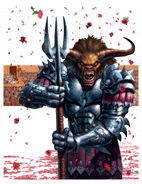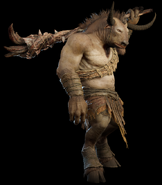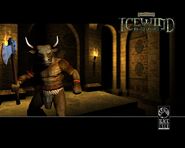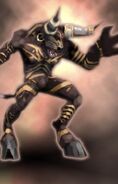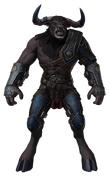Ir'revrykal (talk | contribs) m (+image, shift existing image to gallery) |
SunderedShor (talk | contribs) m (→Appearances) Tag: Source edit |
||
| (93 intermediate revisions by 28 users not shown) | |||
| Line 1: | Line 1: | ||
| − | {{nofootnotes}} |
||
{{Creature |
{{Creature |
||
| − | | image = < |
+ | | image = <gallery> |
| − | + | Minotaur-5e.png|5e |
|
| − | + | Minotaur 4e.jpg|4e |
|
| − | + | Minotaur - Sam Wood.jpg|3e |
|
| − | + | Minotaur.gif|2e |
|
| − | + | Minotaur-1e.jpg|1e |
|
| − | </ |
+ | </gallery> |
| − | | caption = |
+ | | caption = Various depictions of minotaurs. |
| name = Minotaur |
| name = Minotaur |
||
| ⚫ | |||
| size5e = Large |
| size5e = Large |
||
| type5e = [[Monstrosity]] |
| type5e = [[Monstrosity]] |
||
| Line 20: | Line 20: | ||
| type4e = [[Humanoid]] |
| type4e = [[Humanoid]] |
||
| subtype4e = |
| subtype4e = |
||
| − | | alignment4e = |
+ | | alignment4e = |
| refs4e = <ref name="MM4-p190">{{Cite book/Monster Manual 4th edition|190}}</ref> |
| refs4e = <ref name="MM4-p190">{{Cite book/Monster Manual 4th edition|190}}</ref> |
||
| size3e = Large |
| size3e = Large |
||
| Line 34: | Line 34: | ||
| alignment1e = [[Chaotic evil]] |
| alignment1e = [[Chaotic evil]] |
||
| refs1e = <ref name="MM1-p71">{{Cite book/Monster Manual 1st edition|71}}</ref> |
| refs1e = <ref name="MM1-p71">{{Cite book/Monster Manual 1st edition|71}}</ref> |
||
| − | | patron deity = [[Baphomet]]{{ |
+ | | patron deity = [[Baphomet]]<ref name="LCoT-6">{{Cite book/Lost Caverns of Tsojcanth/Monsters and Magical Items|6}}</ref> |
| + | | movement = |
||
| vision = [[Darkvision]]<ref name="MM5e-p223" /><ref name="MMv.3.5-pp188-189" /> |
| vision = [[Darkvision]]<ref name="MM5e-p223" /><ref name="MMv.3.5-pp188-189" /> |
||
| − | | activecycle = |
+ | | activecycle = Any |
| diet = Carnivore<ref name="MM-p252"/> |
| diet = Carnivore<ref name="MM-p252"/> |
||
| − | | lifespan = |
+ | | lifespan = 200 years <ref name="MM-p252" /> |
| + | | location = [[Labyrinth]], [[Underdark]]<ref name="Condemn-p154" /><br/>[[Skullport]], [[Undermountain]]<ref name="RoU-Skul" /><br/>[[Daerndar]], [[Border Kingdoms]]<ref name="poly123" /><br/>[[Kushk]], [[Hordelands]]<ref name="BC-p611" /><br/>[[Omu]], [[Chult]]<ref name="TOA-p123" /><br>[[Huzuz]], [[Zakhara]]<ref name="ALQCoD-p19">{{Cite book/City of Delights/Golden Huzuz|19}}</ref><br/>[[Moonsea]] mountains<ref name="RoA-p86,95" /><br/>[[Nelanther Isles]]<ref name="SWAG-p71" /> |
||
| ⚫ | |||
| + | | intelligence = Low<ref name="MM-p252" /> |
||
| − | | language = [[Abyssal language|Abyssal]],<ref name="MM5e-p223" /> [[Giant language|Giant]]<ref name="MMv.3.5-pp188-189" /> |
+ | | language = [[Common]] (primitive dialect),<ref name="MM-p252" /> [[Minotaur language|Minotaur]],<ref name="Poly63">{{Cite polyhedron/63/Chemcheaux|26,28-29}}</ref> [[Abyssal language|Abyssal]],<ref name="MM5e-p223" /> [[Giant language|Giant]]<ref name="MMv.3.5-pp188-189" /> |
| subraces = |
| subraces = |
||
| − | | climate = |
+ | | climate = Temperate, subtropical<ref name="MM-p252" /> |
| terrain = Underground<ref name="MMv.3.5-pp188-189" /> |
| terrain = Underground<ref name="MMv.3.5-pp188-189" /> |
||
| genrefs = |
| genrefs = |
||
| + | | height = Males – {{SI|9'|'"|long=yes}}<ref name="MMv.3.5-pp188-189" /><br/>Females – {{SI|7|ft}}<ref name="drag116-p32-35" /><ref name="MMv.3.5-pp188-189" /> |
||
| − | | height = 7'1" – 7'5"{{Fact}} |
||
| length = |
| length = |
||
| wingspan = |
| wingspan = |
||
| − | | weight = |
+ | | weight = {{SI|700|lbs|k}} <ref name="MMv.3.5-pp188-189" /> |
| − | | skincolor = Black, brown, |
+ | | skincolor = Black, brown, fair, pale<ref name="MM-p252" /> |
| − | | haircolor = Black, brown |
+ | | haircolor = Black, brown<ref name="MM-p252" /> |
| hairstyles = |
| hairstyles = |
||
| feathers = |
| feathers = |
||
| − | | eyecolor = |
+ | | eyecolor = |
| build = |
| build = |
||
| distinctions = Fierce, physically powerful, fur-covered, hooves, horns, tail |
| distinctions = Fierce, physically powerful, fur-covered, hooves, horns, tail |
||
| appearrefs = |
| appearrefs = |
||
| first = |
| first = |
||
| − | | based = |
+ | | based = [[wikipedia:en:Minotaur|Minotaur]] (Greek) |
| histrefs = |
| histrefs = |
||
}} |
}} |
||
| − | '''Minotaurs''' were a strong and combative race of [[monstrous humanoids]] resembling |
+ | '''Minotaurs''' were a strong and combative race of [[monstrous humanoids]] resembling [[bull]]–[[human]] hybrids<ref name="MM-p252" />. They were rare in [[Faerûn]], outside of their labyrinth homes in the [[Underdark]].<ref name="Underdark-20">{{Cite book/Underdark|20}}</ref><ref name="Underdark-117">{{Cite book/Underdark|117}}</ref> |
| + | |||
| + | {{quote|''I've wielded every weapon man and [[dwarf]] have invented, but nothing compares to these.''|[[Elak]], minotaur [[gladiator]] of [[Thay]], talking about his horns.<ref name="CoR-p63">{{Cite book/Champions of Ruin|63}}</ref>}} |
||
==Description== |
==Description== |
||
| + | [[File:Minotaur undressed.png|thumb|''An unarmored minotaur.''|465x465px]] |
||
| − | Minotaurs were evil giant muscular humanoids with fur-covered bodies and bull-like heads. It was once believed that all minotaurs were male; actually cursed humans that had been altered by the gods or a [[demon lord]] to become a minotaur. That legend proved false as female minotaurs became more prevalent over the years.{{fact}} |
||
| + | Minotaurs were large, muscular [[humanoid]]s. They had the head of a bull, upper torso, hands, and the body of a human,<ref name="TCBoH-43">{{Cite book/The Complete Book of Humanoids|43}}</ref> and hooved feet. Their fur and wild hair typically ranged from brown to black.<ref name="MM-p252" /><ref name="MM5e-p223" /> The fur often covered forearms, chest, abdomen, and legs. Males were referred to as bulls and reached up to {{SI|9'|'"|long=yes}} in height, while females – cows, were similar in appearance, with broader hips, humanoid breasts, and reached only {{SI|7'|'"|long=yes}}.<ref name="drag116-p32-35">{{Cite dragon/116/Ecology of the Minotaur|32-35}}</ref> |
||
| + | Minotaur bodies were of similar shape and build to that of an [[ogre]]. Their hands were huge and strong, ending in thick sharp yellow nails. Minotaurs were known to use claws in battle, but they were brittle and did not survive heavy use. Despite their heads being that of a bull, there were subtle differences in features between mundane beasts and minotaurs. Some were known to have cow-like tails; however, that trait was not common. Their snouts were thicker and longer than that of an animal, and bull-men had sharp carnivore teeth. Their canines were especially noticeable, and minotaurs never hesitated to bite their victims, prey, and opponents. Lastly, unlike bovines, minotaurs' eyes were positioned closer to the center of their faces, granting them good depth perception and another telltale evidence of their predatory nature.<ref name="drag116-p32-35" /> |
||
| − | ==Personality== |
||
| − | Minotaurs were carnivores, but preferred the taste of [[human]] flesh.<ref name="MM-p252">{{Cite book/Monstrous Manual|252}}</ref> They loved to dwell within maze-like caverns or ruins, where their innate sense of direction prevented them from getting lost. They lured travelers into their maze-like homes, where the minotaurs had the advantage over their unfortunate prey.{{fact}} |
||
| + | The creatures' iconic feature – their horns – were very similar to normal bulls', slightly curving forward. Both males and females had similarly shaped huge horns. However, males' were longer and thicker on average. There were several horn coloring variations, and sometimes as many as three colors could be present. Minotaurs with dark fur often had dark yellow or brown horns.<ref name="drag116-p32-35" /> The shortest horns were around {{SI|1'|'"|long=yes}} and could reach up to three times that length.<ref name="MMotM-p27" /> |
||
| − | Many minotaurs couldn't be trusted with non-minotaur races at times, since most humanoids were their meal, and they would do anything for a quick bite out of a sleeping party member, slave owner, or wandering villager. They were not welcomed in any cities, and received an immediate death sentence, or a stoning if caught. Or worse, they were hunted by multiple hunters seeking the thrill of giving the beasts a taste of their own medicine.{{fact}} |
||
==Abilities== |
==Abilities== |
||
| + | Minotaurs possessed almost uncanny tracking and navigational abilities and a superbly keen sense of smell.<ref name="drag116-p32-35" /> They could easily visualize any path they needed to take to get close to the prey.<ref name="MM5e-p223" /> |
||
| − | Minotaurs were not highly intelligent, but possessed instinctive cunning and were adept at ambush attacks. Attacks in the dark were preferred so they could take advantage of their [[infravision]]. Minotaurs could track by scent alone, and would always investigate an unfamiliar scent. Minotaurs were fearless combatants, and would only retreat if their defeat was obvious. |
||
| − | All minotaurs were immune to ''[[maze]]'' |
+ | All minotaurs were immune to ''[[maze]]'' [[spell]]s.<ref name="MM-p252" /> |
| − | == |
+ | ==Personality== |
| + | Minotaurs were always ravenously hungry, a trait that only fueled their aggression.<ref name="MM-p252" /> The youth showed little affection towards their mothers and fathers. Older females received no special treatment and were respected as long as they remained strong and physically superior to the youths. Overall, their society was patriarchal, and those females who were physically weaker than other members of the tribes were treated not much better than slaves. Younger minotaurs often stayed out of the way of older males just to avoid conflicts and brutal assertions of dominance. Adult minotaurs consumed copious amounts of alcohol and dueled over most things: treasures, females, power. Polygamy was common as bulls sought to father a great number of children. In some minotaur communities, males assembled harems of six-seven cows. In some fringe cases, infanticide was practiced in cases when a calf was born with physical deformities. Slavery was not unheard of. Some males kept weaker creatures as slaves while females were put in charge and allowed to take out their frustrations on their bulls' slaves. Despite that, minotaurs disliked torture.<ref name="drag116-p32-35" /> |
||
| − | Many minotaurs worshiped the [[demon lord]] [[Baphomet]] and were not allowed in many cities because of this known factor. Most moved toward the [[chaotic evil]] alignment, and did not work well in groups, packs, or even parties due to their solo hunter-like nature.{{fact}} |
||
| + | |||
| + | Despite minotaurs' general brutality, they had the capability to be kind and empathetic.<ref name="TCBoH-43" /> |
||
| + | |||
| + | ==Combat== |
||
| + | Minotaurs were not highly intelligent but possessed instinctive cunning and were adept at ambush attacks.<ref name="MM-p252" /> They were particularly skilled at hunting their prey. In general, minotaurs preferred melee combat and utilized their horns for charge attacks.<ref name="MMv.3.5-pp188-189" /> Sound of rending flesh, breaking bones, and the scent of blood, sent minotaurs into a blood frenzy, leading to the monstrosities charging and rending any creature they saw.<ref name="MM5e-p223" /> |
||
| + | |||
| + | They wore little to no [[armor]], even when in combat.<ref name="NM">{{Cite book/Night Masks/MMP (2000)|77|7}}</ref><ref name="MM-p252" /> Their favorite weapons were two-handed [[poleaxe]]s, presumably acquired through trade. Other commonly used arms included crude [[club]]s, two-handed [[hammer]]s, [[flail]]s, and occasionally, short and thick [[spear]]s. Ranged weapons were virtually never used.<ref name="drag116-p32-35" /> |
||
| + | |||
| + | ==Biology== |
||
| + | [[File:Minotaur.png|thumb|''Closeup view of a minotaur bull's head.''|245x245px]] |
||
| + | Minotaurs were eternally hungry man-eating carnivores. Despite their ravenousness, they could survive without food for several years.<ref name="MM-p252" /> |
||
| + | |||
| + | Like humans, minotaurs procreated throughout the year. However, as a society, they were guided by the need to replenish their numbers rather than emotions. A typical cow produced one calf; twins were a rare possibility and were considered a religious blessing among minotaurs (sometimes an ill omen). Minotaurs matured much faster than humans: a two-year-old calf had fully formed horns and could kill an orc in combat, a five-year-old minotaur towered over other humanoids, and by their tenth year - minotaurs were considered adults. Minotaurs were capable of procreation as early as three years old in some cases. Culturally, birthing a strong male warrior was considered the height of aspirations for a minotaur cow, while a bull aspired to father as many calves as possible.<ref name="drag116-p32-35" /> |
||
| + | |||
| + | Some sages speculated that minotaurs lived 80 years on average, but determining their longevity was challenging as many of them led violent lives and perished long before their natural expiration. A thirty-year-old minotaur was often thought to be a steeled veteran.<ref name="drag116-p32-35" /> The maximum lifespan was thought to be 200 years.<ref name="MM-p252" /> |
||
| + | |||
| + | Minotaurs could procreate through mating among each other or with a human woman. Children born out of that union were always male minotaurs,<ref name="MM-p252" /> however, at least one human with minotaur heritage existed in the Realms.<ref name="SSEd1">{{cite web| url = https://web.archive.org/web/20220221200233/https://candlekeep.com/library/articles/sse/sse_020304-04.htm| title = So Saith Ed Feb-Apr 2004| accessdate = 7-4-2022| date = 2004}}</ref> |
||
| + | |||
| + | ==Society== |
||
| + | A typical minotaur leader, also known as the elder,<ref name="MM-p252" /> was the biggest and strongest bull in the tribe, which did not necessarily mean the most intelligent leader. The tribe's king led his fellow bulls into raids.<ref name="drag116-p32-35" /> Solitary minotaurs were a common occurrence,<ref name="MM5e-p223" /> however, a clan could have eight members.<ref name="MM-p252" /> |
||
| + | |||
| + | Minotaur youth were taught to fight and master weapons at an early age. In the minotaur society, combat education was done by parents and fellow male tribe members. Even while playing, minotaur children spent most of their time wrestling and fighting each other. Male calves developed brutal and cruel rivalries amongst each other from earliest childhood, and these feuds were encouraged by the adults.<ref name="drag116-p32-35" /> |
||
| + | |||
| + | Minotaurs were proud of their horns and often spent their free time sharpening, cleaning, and polishing them with old rags or furs. In some minotaur societies, the color of their horns determined their status within the community and attractiveness. In minotaur tribes that preferred darker-colored horns, individuals often used [[oil]]s and [[polish]]es to artificially darken them. Decorations were common as well. [[Brass]] and [[silver]] tacks and spikes were used to accentuate the horns' natural appeal. Repaired severed horns were common in tribes with talented crafters or skilled allies who knew how to work metals. After a duel, the winner customarily took the left horn of their opponent, often leaving the opponent maimed and badly injured. These horns were hollowed out and turned into wind [[horn|musical instruments]], and stronger individuals often owned several.<ref name="drag116-p32-35" /> |
||
| + | |||
| + | Apart from horn decorations, minotaurs rarely wore any other type of jewelry. The closest to what humans consider decorations among minotaurs were fanciful [[girdle]]s or [[gauntlet]]s. Sages speculated that minotaurs were known to easily adapt traditions and norms from other races and societies in lieu of their own culture. Of course, those cultural norms that were aimed at aggression and intimidation were highly preferred and emulated.<ref name="drag116-p32-35" /> |
||
| + | |||
| + | When interacting with other races, minotaurs got along well with ogres. They respected [[giant]]s and [[troll]]s for their strength. Smaller humanoids, such as humans, elves, dwarves, and others, were considered beneath minotaurs in all senses of the word. Bulls could not, or didn't care enough to distinguish one humanoid from another.<ref name="drag116-p32-35" /> [[Gnoll]]s and minotaurs hated each other and immediately attacked each other on sight.<ref name="MM-p252" /> |
||
| + | |||
| + | ===Religion=== |
||
| + | Many minotaurs worshiped the [[demon lord]] [[Baphomet]]<ref name="MM5e-p51">{{Cite book/Monster Manual 5th edition|51}}</ref> and kept themselves, and their society, secluded. Most were inclined to evil and chaotic acts and did not work well in groups, packs, or even parties due to their solitary hunter-like nature.<ref name="MM4-p190" /> Levels of reverence and even religious traditions varied greatly among different minotaur communities.<ref name="drag116-p32-35" /> |
||
| + | |||
| + | Priests decorated their horns with carved pictograms. The images were filled with blood to darken the designs, and finally, the horns were stained with yellowing agents. Instead of priestly garb, minotaur priests decorated their bodies with soil, dirt, plant matter, and blood spilled in battle. Gnoll blood was the preferred decoration for a reason known to none but priests themselves. The worship was centered on sacrificial ceremonies that took place in the heart of labyrinthine minotaur homes, adorned with bones of precious victims. The most common sacrifice was a human. Minotaur clerics received little respect apart from the respect earned through physical strength. However, horns collected from defeated bull priests were considered extremely valuable.<ref name="drag116-p32-35" /> |
||
| + | |||
| + | Death was not feared in minotaur society. On the contrary, death was considered to be a holy event. Minotaurs thought good death to be quick, clean, and in a rush of battle. Honor kills were a staple of minotaurs' cultural and religious creed.<ref name="drag116-p32-35" /> |
||
| + | |||
| + | ===Magic=== |
||
| + | Arcane spellcasting was extremely rare among minotaurs as most lacked the curiosity to pursue ''[[the Art]]''. Minotaurs could be easily fooled by wizardly spells. However, if the duping was discovered, the magic and its caster were treated with extreme prejudice.<ref name="drag116-p32-35" /> |
||
| + | |||
| + | Divine magics granted to clerics were seldom of healing nature, instead, being battle-focused. Magics such as ''[[bull's strength]]'' were the most used.<ref name="drag116-p32-35" /> |
||
| + | |||
| + | Magic items held little value for most minotaurs and were traded away for other valuables or alcohol most of the time.<ref name="drag116-p32-35" /> |
||
| + | |||
| + | ===Language=== |
||
| + | [[Minotaur language]] was very similar to the [[Ogre language]], allowing those who were proficient in one tongue quickly pick up the intricacies of the other. One unique part of the Minotaur language was a number of vocalizations only known and comprehendible by their own kin, reminiscent of grunts and sounds emitted by mundane cattle bulls, by some accounts.<ref name="drag116-p32-35" /> |
||
| + | |||
| + | ===Homelands=== |
||
| + | [[File:Thayan Gladiator.jpg|thumb|''A powerful minotaur gladiator from [[Thay]].''|370x370px]] |
||
| + | Minotaurs were most likely found in their underground labyrinthine homes, dungeons,<ref name="MM4-p190" /><ref name="MM-p252" /><ref name="MM1-p71" /> or thickest of forests.<ref name="drag116-p32-35" /> Sometimes evil wizards were known to place a clan of minotaurs inside a labyrinth and feeding them interlopers and adventurers.<ref name="MM-p252" /> There, minotaurs' innate sense of direction prevented them from getting lost.<ref name="MMv.3.5-pp188-189" /> They often made their money by plundering and raiding passers by, but also sought employment as mercenaries, fighters and servants. Minotaurs were also often kept as slaves by [[Underdark]] inhabitants, such as [[mind flayers]] and [[drow]].<ref name="Underdark-117" /><ref name="Underdark-20">{{Cite book/Underdark|20}}</ref> |
||
| + | |||
| + | A reasonably sized population could be found within the Underdark in an area known as the [[Labyrinth]], and an occasionally – in the underground city of [[Skullport]] in [[Undermountain]], as of the late 14{{th}} century [[DR]].<ref name="Condemn-p154">{{Cite book/Condemnation/Paperback|154}}</ref><ref name="FRCS-212">{{Cite book/Forgotten Realms Campaign Setting 3rd edition|212}}</ref><ref name="RoU-Skul">{{Cite book/Realms of the Underdark/A Slow Day in Skullport}}</ref> |
||
| + | |||
| + | [[Nelanther Isles]] was known for a population of sea-faring pirate minotaurs as of the late 15{{th}} century DR.<ref name="SWAG-p71">{{Cite book/Sword Coast Adventurer's Guide|71}}</ref> Mountains of the [[Moonsea]] were home to sporadic bands of minotaurs,<ref name="RoA-p86,95">{{Cite book/Ruins of Adventure|86,95}}</ref> as well as deserts of [[Raurin]].<ref name="DOD-p51">{{Cite book/Desert of Desolation|51}}</ref> The city of [[Kushk]] in the [[Hordelands]] was occupied by a wide variety of monster races. One of the city's wards - aptly named [[Minotaur City]], was a district of narrow maze-like alleys and home of the city's minotaur population.<ref name="BC-p611">{{Cite book/Blood Charge|61}}</ref> Minotaurs also were among more exotic inhabitants of [[Huzuz]] in [[Zakhara]].<ref name="ALQCoD-p19" /> |
||
| + | |||
| + | The caves of [[Daerndar]], in the [[Grand Duchy of Shantal]] of the [[Border Kingdoms]], were affected by storms of wild magics and spellstorms. Among creatures spirited into the caverns was a significant number of minotaurs.<ref name="poly123">{{Cite polyhedron/123/Elminster's Everwinking Eye: The Border Kingdoms|9}}</ref> Another population of minotaurs lived in peace with humans in the Chultan city of [[Omu]] until the city was enslaved by [[lich]] [[Acererak]] long before the 13{{th}} century DR.<ref name="TOA-p123">{{Cite book/Tomb of Annihilation|123}}</ref> |
||
| + | |||
| + | Outside of [[Toril]], minotaurs inhabited numerous [[crystal sphere]]s, most notably, on the world of [[Krynn]],<ref name="PoC-p28">{{Cite book/Planes of Conflict/A Player's Guide to Conflict|28}}</ref> and could be found in the [[Domains of Dread]].<ref name="SP">{{Cite game/Ravenloft: Stone Prophet}}</ref> In the planes, numerous minotaur tribes roamed the Endless Maze in the [[Abyss]] – the layer where the minotaur deity Baphomet dwelt.<ref name="MotP-p81">{{Cite book/Manual of the Planes 4th edition|81}}</ref> |
||
| + | |||
| + | ==Ecology== |
||
| + | In the ancient Empire of [[Netheril]], minotaur tail hairs were used to make special braided brushes. These items were used in [[arcane magic]] rituals.<ref name="RoA-trial">{{Cite book/Realms of Shadow/Trial by Ordeal}}</ref> [[Oil of minotaur musk]] was a rare commodity imported into [[Waterdeep]] and often imitated and faked by some industrious individuals.<ref name="SS-ch5">{{Cite book/Silver Shadows||5}}</ref> Minotaur parts were used in creation of certain [[potion]]s and as [[material component]]s for spells that dealt with physical strength, location, and misdirection,<ref name="MM-p252" /> one notable use being a minotaur's heart used in creation and animation of fearsome [[minogon]] [[construct]]s.<ref name="nwn">{{Cite game/Neverwinter Nights}}</ref> Powdered horn of a minotaur was the main component in ''[[oil of impact]].''<ref name="drag130">{{Cite dragon/130/Better Living Through Alchemy|40}}</ref> The same material was the material component needed to cast the [[Old Empires]] spell – ''[[Horns of Hathor]]''.<ref name="pp-p108">{{Cite book/Powers & Pantheons|108}}</ref> |
||
| + | |||
| + | ==History== |
||
| + | [[File:Cultist minotaur.png|thumb|''[[Zegdar]] of the [[Emberhorn]] tribe.''|370x370px]] |
||
| + | The origin of the minotaur species was unknown. However, some speculated that [[Geryon]] molded the first bull-men out of ogres. This claim was quite dubious as minotaurs never uttered Geryon's name and only swore or praised Baphomet.<ref name="drag116-p32-35" /> Another theory was that the first especially devote cultists of Baphomet the Horned King were transformed into minotaurs as this transformation was considered the highest honor in the Demon Lord's church.<ref name="Mtof-p142">{{Cite book/Mordenkainen's Tome of Foes|142}}</ref><ref name="MM5e-p223" /> Yet another myth talked about the [[Lady of Pain]], the mysterious power that ruled over [[Sigil]]. These tales claimed that the first minotaurs were created by her to guard the Lady's many magical planar maze prisons.<ref name="MMotM-p27">{{Cite book/Mordenkainen Presents: Monsters of the Multiverse|142}}</ref> Yet one more legend claimed that minotaurs were created by some ''curse'' placed on a human fighter who wanted to be "as strong as a bull" for "crimes against the natural order." The same school of thought mistakingly believed that minotaurs were exclusively male.<ref name="MM-p252" /> Among planar creatures and inhabitants of [[Sigil]], a common legend stated that [[bulezau]] were created by Baphomet through crossbreeding minotaurs and [[tanar'ri]]. However, the legend remained unconfirmed.<ref name="PS-MC2-p109">{{Cite book/Monstrous Compendium Planescape Appendix II|109}}</ref> |
||
| + | |||
| + | In the {{YearlinkName|-10000}}, minotaurs were forced to flee [[Narathmault]] along with their [[drow]] masters, traveling to the underground caverns of [[Plateau of Thay]].<ref name="Grand History-15">{{Cite book/The Grand History of the Realms|15}}</ref> |
||
| + | |||
| + | Apart from that, not much was known of Minotaur history, but it was said that the Labyrinth was once an empire, rather than the uncivilized lands it was known as.<ref name="Underdark-117" /><ref name="Underdark-158">{{Cite book/Underdark|158}}</ref> |
||
| + | |||
| + | In the {{YearlinkName|1322}}, a band of roving minotaurs ravaged a small town of the [[Dead Tree Hollow]] in the [[Vast]]. One of the survivors of the attack was a five-year-old [[Tordon Sureblade]], who escaped to the city of [[Ravens Bluff]] with his father. Tordon eventually became the Lord Magistrate of Ravens Bluff.<ref name="poly148">{{Cite polyhedron/148/Pillars of Ravens Bluff|18}}</ref> |
||
| + | |||
| + | In the 14{{th}} century DR, peaceful minotaurs were known to frequent [[Beruintar's Hone Warmer]] inn in [[Waymoot]]<ref name="volo-Corm">{{Cite book/Volo's Guide to Cormyr|178}}</ref> and be among members of the [[Fall of Stars]] adventurers' guild of the [[Dalelands]].<ref name="volo-D">{{Cite book/Volo's Guide to the Dalelands|147}}</ref> |
||
| + | |||
| + | In the {{YearlinkName|1491}}, the [[Emberhorn]] minotaur tribe under the leadership of [[Zegdar]], joined forces with the [[Cult of the Eternal Flame]]. The tribe's leader was blessed by his deity [[Imix]] and led the tribe down a destructive path. The Emberhorns often beheaded their opponents and roasted the heads in hot coals in praise of the All-Consuming Fire.<ref name="POA-p120">{{Cite book/Princes of the Apocalypse|120}}</ref> |
||
| + | |||
| + | ==Notable Minotaurs== |
||
| + | [[File:Minotaur NWN.jpg|thumb|''[[Redtip]], ring fighter and a pirate from the [[Nelanther Isles]].''|310x310px]] |
||
| + | *[[Ahurrong]], the chief overseer of [[Thyvo Vrass]]'s estate in [[Thay]] in the mid-to-late 14{{th}} century DR.<ref name="SB-p132">{{Cite book/Spellbound/Campaign Guide|32}}</ref> |
||
| + | *[[Karagos]], a great champion of Omu in Chult whose skull was fixed on a throne in lich Acererak's ruined city.<ref name="TOA-p164">{{Cite book/Tomb of Annihilation|164}}</ref> |
||
| + | *[[Magrath the Minotaur|Magrath]], a minotaur pirate lord ''circa'' [[432 DR]].<ref name="CaN-p240-241">{{Cite book/Cormyr: A Novel/Paperback 1998|240-241}}</ref> |
||
| + | *[[Red Minotaur]], a famed gladiator of [[Hillsfar]] who claimed his freedom in the late-14{{th}} century DR.<ref name="Hills">{{Cite game/Hillsfar}}</ref><ref name="NWN-T">{{Cite game/Neverwinter Nights: Tyrants of the Moonsea}}</ref> |
||
| + | *[[Suryris]], an honorable white minotaur duelist from the [[Orsraun Mountains]] in [[Turmish]].<ref name="bg">{{Cite game/Baldur's Gate}}</ref> |
||
| + | *[[Taurus]], another famed gladiator of Hillsfar, a mascot and an ally of the city's [[Red Plumes]] in the mid-to-late 14{{th}} century DR.<ref name="FRA-p88">{{Cite book/Forgotten Realms Adventures|88}}</ref> |
||
| + | *[[Thoele Raervrun]], a storeowner who was ''cursed'' to become a minotaur. He ran [[Skulls New and Used]] in the city of [[Oeble]] in the late 14{{th}} century DR.<ref name="poly-139">{{Cite polyhedron/139/Elminster's Everwinking Eye: A Wayfarers Guide to the Forgotten Realms|16}}</ref> |
||
| + | *[[Thud]], an innkeeper from [[Thentia]] who ran [[The Inlet]], renowned for its peaceful atmosphere.<ref name="MOO-p42">{{Cite book/The Moonsea/Reference Guide|42}}</ref><ref name="Tyr">{{Cite game/Neverwinter Nights: Tyrants of the Moonsea}}</ref> |
||
| + | *[[Zaal]], a minotaur trapped in a ''[[mirror of life trapping]]'' by lich Acererak.<ref name="TOA-p163">{{Cite book/Tomb of Annihilation|163}}</ref> |
||
| + | |||
| + | ==Rumors & Legends== |
||
| + | *A rumor circulated tavern in late 15{{th}} century [[Chult]]. Stories claimed a lost ancient city of Omu built by minotaurs deep in the jungles and overrun by [[yuan-ti]].<ref name="TOA-p36">{{Cite book/Tomb of Annihilation|36}}</ref> |
||
==Appendix== |
==Appendix== |
||
| + | ===See Also=== |
||
| + | *[[Baphitaur]] |
||
| + | *[[Bulezau]] |
||
| + | *[[Ghour]] |
||
| + | *[[Goristro]] |
||
| + | *[[Minogon]] |
||
| + | |||
===Appearances=== |
===Appearances=== |
||
| + | {{Appearances |
||
| − | ;Adventures: |
||
| + | | adventures = ''[[Ruins of Adventure]]'';''[[Desert of Desolation]]'';''[[The Throne of Bloodstone]]'';''[[Curse of the Azure Bonds]]'';''[[Blood Charge]]'';''[[Four from Cormyr]]'';''[[For Duty & Deity]]'';''[[Undermountain: Stardock]]'';''[[Expedition to Undermountain]]'';[[Dungeon magazine 206|''Dungeon'' #206, "Eyes on the Ball"]];''[[Ghosts of Dragonspear Castle]]'';''[[Princes of the Apocalypse]]'';''[[Out of the Abyss]]'';''[[Tomb of Annihilation]]'';''[[Waterdeep: Dragon Heist]]'';''[[Waterdeep: Dungeon of the Mad Mage]]'';''[[Baldur's Gate: Descent into Avernus]]'' |
||
| − | * ''[[Expedition to Undermountain]]'' |
||
| + | | adventure refs = ''[[Undermountain: The Lost Level]]'' |
||
| − | ;Computer Games: |
||
| + | | novels = ''[[Cormyr: A Novel]]'';{{Anthapp|Realms of the Underdark|A Slow Day in Skullport}};''[[Starless Night]]'';''[[Siege of Darkness]]'';{{Anthapp|Realms of the Arcane|Secrets of Blood, Spirits of the Sea}};''[[Night Masks (novel)|Night Masks]]'';''[[Baldur's Gate II: Shadows of Amn (novel)|Baldur's Gate II: Shadows of Amn]]'';''[[Masquerades]]'';''[[Daughter of the Drow]]'';''[[Windwalker (novel)|Windwalker]]'';''[[Prince of Lies (novel)|Prince of Lies]]'';''[[Crucible: The Trial of Cyric the Mad]]'';''[[Easy Betrayals]]'';''[[Dissolution]]'';''[[Condemnation]]'';''[[Storm of the Dead]]'';''[[Ascendancy of the Last]]'';''[[Sandstorm (novel)|Sandstorm]]'';''[[The Spectral Blaze]]'';''[[Timeless]]'' |
||
| − | * ''[[Baldur's Gate: Dark Alliance]]'' |
||
| + | | novel refs = {{Anthapp|Realms of Shadow|Trial by Ordeal}};{{Anthapp|Realms of Infamy|Laughter in the Flames}};''[[The Fallen Fortress]]'';''[[The Silent Blade]]'';''[[Murder in Halruaa]]'';''[[Tymora's Luck]]'';''[[Depths of Madness (novel)|Depths of Madness]]'';''[[Heirs of Prophecy]]'';''[[Sword of the Gods]]'';''[[Prophet of the Dead]]'';''[[Prince of Ravens]]'';''[[Venom in Her Veins]]'';''[[Fire in the Blood]]'' |
||
| − | * ''[[Baldur's Gate II: Enhanced Edition]]'' |
||
| + | | comics = {{Comapp|A Darkened Wish|1}} |
||
| ⚫ | |||
| + | | video games = {{PRapp|PoR|CAB|SSB}};''[[Hillsfar (game)|Hillsfar]]'';''[[Forgotten Realms: Unlimited Adventures]]'';''[[Neverwinter Nights (AOL game)]]'';''[[Eye of the Beholder III: Assault on Myth Drannor]]'';''[[Dungeon Hack]]'';''[[Ravenloft: Stone Prophet]]'';''[[Icewind Dale (game)|Icewind Dale]]'';''[[Baldur's Gate: Dark Alliance]]'';{{BGapp|SoA|EE2|III}};''[[Neverwinter Nights: Pirates of the Sword Coast]]'';''[[Idle Champions of the Forgotten Realms]]'';''[[Neverwinter Nights: Tyrants of the Moonsea]]'' |
||
| − | * ''[[Curse of the Azure Bonds (game)|Curse of the Azure Bonds]]'' |
||
| ⚫ | |||
| − | * ''[[Eye of the Beholder III: Assault on Myth Drannor]]'' |
||
| + | | board games = ''[[Battle for Faerûn]]'';''[[Betrayal at Baldur's Gate]]'';''[[Dungeons & Dragons: Bedlam in Neverwinter]]'' |
||
| − | * ''[[Hillsfar (game)|Hillsfar]]'' |
||
| + | | card games = ''[[AD&D Trading Cards]]'';''[[Dragonfire]]'' |
||
| − | * ''[[Icewind Dale: Enhanced Edition]]'' |
||
| − | + | | miniatures = ''[[Icons of the Realms]]'' |
|
| + | | organized play = ''[[Zhent's Ancient Shadows]]'';''[[Nurture and Nature]]'';[[Black Blood (adventure)|''Black Blood'']];''[[Outlaws of the Iron Route]]'';''[[Blood Above, Blood Below]]'';''[[The Iron Baron]]'';''[[Peril at the Port]]'';''[[The Ark of the Mountains]]'';''[[Over the Edge]]'';''[[The Vampire of Skullport]]'' |
||
| − | * ''[[Neverwinter Nights: Pirates of the Sword Coast]]'' |
||
| + | }} |
||
| − | * ''[[Pool of Radiance (game)|Pool of Radiance]]'' |
||
| − | * ''[[Secret of the Silver Blades]]'' |
||
| − | ;Novels: |
||
| − | * ''[[Condemnation]]'' |
||
| − | * ''[[Night Masks]]'' |
||
| − | * ''[[Sandstorm (novel)|Sandstorm]]'' |
||
| − | * ''[[Storm of the Dead]]'' |
||
===Gallery=== |
===Gallery=== |
||
<gallery> |
<gallery> |
||
| − | + | Minotaur - marc sasso.jpg|''A minotaur [[gladiator]].'' |
|
| + | Minotaur bg3.png|''One of the [[minotaur]]s encountered in the [[Underdark]].'' |
||
| + | IWD wallpaper minotaur.jpg|''A promotional wallpaper for [[Icewind Dale (game)]].'' |
||
| + | Minotaur-wow.jpg|''A depiction of a minotaur from [[Warriors of Waterdeep]].'' |
||
| + | Minotaur wizard NWN.jpg|''A minotaur [[wizard]].'' |
||
| + | Minotaur merc.png|''A minotaur mercenary from the [[Underdark]].'' |
||
| + | Minotaurs of stormhorns.png|''A minotaur of the [[Labyrinthine Cavern]], servant of the [[drow]].'' |
||
| + | Minotaur POR sprite.gif|''Minotaur from [[Pool of Radiance (game)]].'' |
||
</gallery> |
</gallery> |
||
===Further Reading=== |
===Further Reading=== |
||
| − | * |
+ | *{{Cite dragon/116/Ecology of the Minotaur|33-35}} |
| − | * |
+ | *{{Cite book/Savage Species}} |
===External Links=== |
===External Links=== |
||
| + | {{External link disclaimer}} |
||
| + | * {{Dragonlance Wiki external link}} |
||
* {{EW}} |
* {{EW}} |
||
| + | * {{NWNW}} |
||
| + | * {{BG3}} |
||
===References=== |
===References=== |
||
| Line 117: | Line 222: | ||
[[de:Minotauren]] |
[[de:Minotauren]] |
||
[[Category:Races]] |
[[Category:Races]] |
||
| + | [[Category:Spell components]] |
||
Latest revision as of 07:46, 16 January 2024
Minotaurs were a strong and combative race of monstrous humanoids resembling bull–human hybrids[4]. They were rare in Faerûn, outside of their labyrinth homes in the Underdark.[17][18]
Description[]
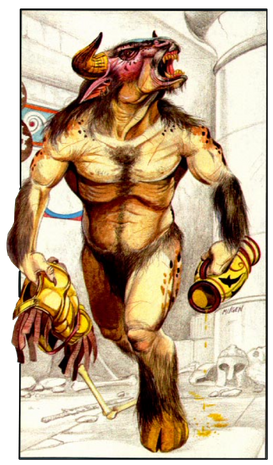
An unarmored minotaur.
Minotaurs were large, muscular humanoids. They had the head of a bull, upper torso, hands, and the body of a human,[20] and hooved feet. Their fur and wild hair typically ranged from brown to black.[4][1] The fur often covered forearms, chest, abdomen, and legs. Males were referred to as bulls and reached up to 9 feet (2.7 meters) in height, while females – cows, were similar in appearance, with broader hips, humanoid breasts, and reached only 7 feet (2.1 meters).[16]
Minotaur bodies were of similar shape and build to that of an ogre. Their hands were huge and strong, ending in thick sharp yellow nails. Minotaurs were known to use claws in battle, but they were brittle and did not survive heavy use. Despite their heads being that of a bull, there were subtle differences in features between mundane beasts and minotaurs. Some were known to have cow-like tails; however, that trait was not common. Their snouts were thicker and longer than that of an animal, and bull-men had sharp carnivore teeth. Their canines were especially noticeable, and minotaurs never hesitated to bite their victims, prey, and opponents. Lastly, unlike bovines, minotaurs' eyes were positioned closer to the center of their faces, granting them good depth perception and another telltale evidence of their predatory nature.[16]
The creatures' iconic feature – their horns – were very similar to normal bulls', slightly curving forward. Both males and females had similarly shaped huge horns. However, males' were longer and thicker on average. There were several horn coloring variations, and sometimes as many as three colors could be present. Minotaurs with dark fur often had dark yellow or brown horns.[16] The shortest horns were around 1 foot (0.3 meters) and could reach up to three times that length.[21]
Abilities[]
Minotaurs possessed almost uncanny tracking and navigational abilities and a superbly keen sense of smell.[16] They could easily visualize any path they needed to take to get close to the prey.[1]
All minotaurs were immune to maze spells.[4]
Personality[]
Minotaurs were always ravenously hungry, a trait that only fueled their aggression.[4] The youth showed little affection towards their mothers and fathers. Older females received no special treatment and were respected as long as they remained strong and physically superior to the youths. Overall, their society was patriarchal, and those females who were physically weaker than other members of the tribes were treated not much better than slaves. Younger minotaurs often stayed out of the way of older males just to avoid conflicts and brutal assertions of dominance. Adult minotaurs consumed copious amounts of alcohol and dueled over most things: treasures, females, power. Polygamy was common as bulls sought to father a great number of children. In some minotaur communities, males assembled harems of six-seven cows. In some fringe cases, infanticide was practiced in cases when a calf was born with physical deformities. Slavery was not unheard of. Some males kept weaker creatures as slaves while females were put in charge and allowed to take out their frustrations on their bulls' slaves. Despite that, minotaurs disliked torture.[16]
Despite minotaurs' general brutality, they had the capability to be kind and empathetic.[20]
Combat[]
Minotaurs were not highly intelligent but possessed instinctive cunning and were adept at ambush attacks.[4] They were particularly skilled at hunting their prey. In general, minotaurs preferred melee combat and utilized their horns for charge attacks.[3] Sound of rending flesh, breaking bones, and the scent of blood, sent minotaurs into a blood frenzy, leading to the monstrosities charging and rending any creature they saw.[1]
They wore little to no armor, even when in combat.[22][4] Their favorite weapons were two-handed poleaxes, presumably acquired through trade. Other commonly used arms included crude clubs, two-handed hammers, flails, and occasionally, short and thick spears. Ranged weapons were virtually never used.[16]
Biology[]
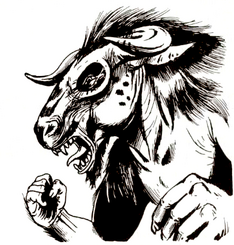
Closeup view of a minotaur bull's head.
Minotaurs were eternally hungry man-eating carnivores. Despite their ravenousness, they could survive without food for several years.[4]
Like humans, minotaurs procreated throughout the year. However, as a society, they were guided by the need to replenish their numbers rather than emotions. A typical cow produced one calf; twins were a rare possibility and were considered a religious blessing among minotaurs (sometimes an ill omen). Minotaurs matured much faster than humans: a two-year-old calf had fully formed horns and could kill an orc in combat, a five-year-old minotaur towered over other humanoids, and by their tenth year - minotaurs were considered adults. Minotaurs were capable of procreation as early as three years old in some cases. Culturally, birthing a strong male warrior was considered the height of aspirations for a minotaur cow, while a bull aspired to father as many calves as possible.[16]
Some sages speculated that minotaurs lived 80 years on average, but determining their longevity was challenging as many of them led violent lives and perished long before their natural expiration. A thirty-year-old minotaur was often thought to be a steeled veteran.[16] The maximum lifespan was thought to be 200 years.[4]
Minotaurs could procreate through mating among each other or with a human woman. Children born out of that union were always male minotaurs,[4] however, at least one human with minotaur heritage existed in the Realms.[23]
Society[]
A typical minotaur leader, also known as the elder,[4] was the biggest and strongest bull in the tribe, which did not necessarily mean the most intelligent leader. The tribe's king led his fellow bulls into raids.[16] Solitary minotaurs were a common occurrence,[1] however, a clan could have eight members.[4]
Minotaur youth were taught to fight and master weapons at an early age. In the minotaur society, combat education was done by parents and fellow male tribe members. Even while playing, minotaur children spent most of their time wrestling and fighting each other. Male calves developed brutal and cruel rivalries amongst each other from earliest childhood, and these feuds were encouraged by the adults.[16]
Minotaurs were proud of their horns and often spent their free time sharpening, cleaning, and polishing them with old rags or furs. In some minotaur societies, the color of their horns determined their status within the community and attractiveness. In minotaur tribes that preferred darker-colored horns, individuals often used oils and polishes to artificially darken them. Decorations were common as well. Brass and silver tacks and spikes were used to accentuate the horns' natural appeal. Repaired severed horns were common in tribes with talented crafters or skilled allies who knew how to work metals. After a duel, the winner customarily took the left horn of their opponent, often leaving the opponent maimed and badly injured. These horns were hollowed out and turned into wind musical instruments, and stronger individuals often owned several.[16]
Apart from horn decorations, minotaurs rarely wore any other type of jewelry. The closest to what humans consider decorations among minotaurs were fanciful girdles or gauntlets. Sages speculated that minotaurs were known to easily adapt traditions and norms from other races and societies in lieu of their own culture. Of course, those cultural norms that were aimed at aggression and intimidation were highly preferred and emulated.[16]
When interacting with other races, minotaurs got along well with ogres. They respected giants and trolls for their strength. Smaller humanoids, such as humans, elves, dwarves, and others, were considered beneath minotaurs in all senses of the word. Bulls could not, or didn't care enough to distinguish one humanoid from another.[16] Gnolls and minotaurs hated each other and immediately attacked each other on sight.[4]
Religion[]
Many minotaurs worshiped the demon lord Baphomet[24] and kept themselves, and their society, secluded. Most were inclined to evil and chaotic acts and did not work well in groups, packs, or even parties due to their solitary hunter-like nature.[2] Levels of reverence and even religious traditions varied greatly among different minotaur communities.[16]
Priests decorated their horns with carved pictograms. The images were filled with blood to darken the designs, and finally, the horns were stained with yellowing agents. Instead of priestly garb, minotaur priests decorated their bodies with soil, dirt, plant matter, and blood spilled in battle. Gnoll blood was the preferred decoration for a reason known to none but priests themselves. The worship was centered on sacrificial ceremonies that took place in the heart of labyrinthine minotaur homes, adorned with bones of precious victims. The most common sacrifice was a human. Minotaur clerics received little respect apart from the respect earned through physical strength. However, horns collected from defeated bull priests were considered extremely valuable.[16]
Death was not feared in minotaur society. On the contrary, death was considered to be a holy event. Minotaurs thought good death to be quick, clean, and in a rush of battle. Honor kills were a staple of minotaurs' cultural and religious creed.[16]
Magic[]
Arcane spellcasting was extremely rare among minotaurs as most lacked the curiosity to pursue the Art. Minotaurs could be easily fooled by wizardly spells. However, if the duping was discovered, the magic and its caster were treated with extreme prejudice.[16]
Divine magics granted to clerics were seldom of healing nature, instead, being battle-focused. Magics such as bull's strength were the most used.[16]
Magic items held little value for most minotaurs and were traded away for other valuables or alcohol most of the time.[16]
Language[]
Minotaur language was very similar to the Ogre language, allowing those who were proficient in one tongue quickly pick up the intricacies of the other. One unique part of the Minotaur language was a number of vocalizations only known and comprehendible by their own kin, reminiscent of grunts and sounds emitted by mundane cattle bulls, by some accounts.[16]
Homelands[]
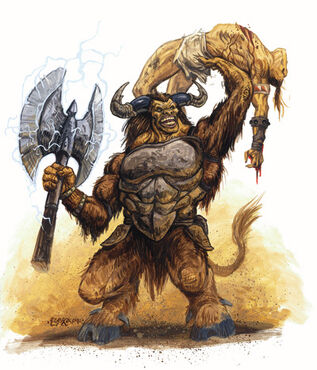
A powerful minotaur gladiator from Thay.
Minotaurs were most likely found in their underground labyrinthine homes, dungeons,[2][4][5] or thickest of forests.[16] Sometimes evil wizards were known to place a clan of minotaurs inside a labyrinth and feeding them interlopers and adventurers.[4] There, minotaurs' innate sense of direction prevented them from getting lost.[3] They often made their money by plundering and raiding passers by, but also sought employment as mercenaries, fighters and servants. Minotaurs were also often kept as slaves by Underdark inhabitants, such as mind flayers and drow.[18][17]
A reasonably sized population could be found within the Underdark in an area known as the Labyrinth, and an occasionally – in the underground city of Skullport in Undermountain, as of the late 14th century DR.[7][25][8]
Nelanther Isles was known for a population of sea-faring pirate minotaurs as of the late 15th century DR.[14] Mountains of the Moonsea were home to sporadic bands of minotaurs,[13] as well as deserts of Raurin.[26] The city of Kushk in the Hordelands was occupied by a wide variety of monster races. One of the city's wards - aptly named Minotaur City, was a district of narrow maze-like alleys and home of the city's minotaur population.[10] Minotaurs also were among more exotic inhabitants of Huzuz in Zakhara.[12]
The caves of Daerndar, in the Grand Duchy of Shantal of the Border Kingdoms, were affected by storms of wild magics and spellstorms. Among creatures spirited into the caverns was a significant number of minotaurs.[9] Another population of minotaurs lived in peace with humans in the Chultan city of Omu until the city was enslaved by lich Acererak long before the 13th century DR.[11]
Outside of Toril, minotaurs inhabited numerous crystal spheres, most notably, on the world of Krynn,[27] and could be found in the Domains of Dread.[28] In the planes, numerous minotaur tribes roamed the Endless Maze in the Abyss – the layer where the minotaur deity Baphomet dwelt.[29]
Ecology[]
In the ancient Empire of Netheril, minotaur tail hairs were used to make special braided brushes. These items were used in arcane magic rituals.[30] Oil of minotaur musk was a rare commodity imported into Waterdeep and often imitated and faked by some industrious individuals.[31] Minotaur parts were used in creation of certain potions and as material components for spells that dealt with physical strength, location, and misdirection,[4] one notable use being a minotaur's heart used in creation and animation of fearsome minogon constructs.[32] Powdered horn of a minotaur was the main component in oil of impact.[33] The same material was the material component needed to cast the Old Empires spell – Horns of Hathor.[34]
History[]
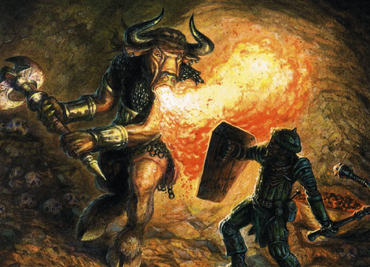
Zegdar of the Emberhorn tribe.
The origin of the minotaur species was unknown. However, some speculated that Geryon molded the first bull-men out of ogres. This claim was quite dubious as minotaurs never uttered Geryon's name and only swore or praised Baphomet.[16] Another theory was that the first especially devote cultists of Baphomet the Horned King were transformed into minotaurs as this transformation was considered the highest honor in the Demon Lord's church.[35][1] Yet another myth talked about the Lady of Pain, the mysterious power that ruled over Sigil. These tales claimed that the first minotaurs were created by her to guard the Lady's many magical planar maze prisons.[21] Yet one more legend claimed that minotaurs were created by some curse placed on a human fighter who wanted to be "as strong as a bull" for "crimes against the natural order." The same school of thought mistakingly believed that minotaurs were exclusively male.[4] Among planar creatures and inhabitants of Sigil, a common legend stated that bulezau were created by Baphomet through crossbreeding minotaurs and tanar'ri. However, the legend remained unconfirmed.[36]
In the −10000 DR, minotaurs were forced to flee Narathmault along with their drow masters, traveling to the underground caverns of Plateau of Thay.[37]
Apart from that, not much was known of Minotaur history, but it was said that the Labyrinth was once an empire, rather than the uncivilized lands it was known as.[18][38]
In the Year of Lurking Death, 1322 DR, a band of roving minotaurs ravaged a small town of the Dead Tree Hollow in the Vast. One of the survivors of the attack was a five-year-old Tordon Sureblade, who escaped to the city of Ravens Bluff with his father. Tordon eventually became the Lord Magistrate of Ravens Bluff.[39]
In the 14th century DR, peaceful minotaurs were known to frequent Beruintar's Hone Warmer inn in Waymoot[40] and be among members of the Fall of Stars adventurers' guild of the Dalelands.[41]
In the Year of the Scarlet Witch, 1491 DR, the Emberhorn minotaur tribe under the leadership of Zegdar, joined forces with the Cult of the Eternal Flame. The tribe's leader was blessed by his deity Imix and led the tribe down a destructive path. The Emberhorns often beheaded their opponents and roasted the heads in hot coals in praise of the All-Consuming Fire.[42]
Notable Minotaurs[]
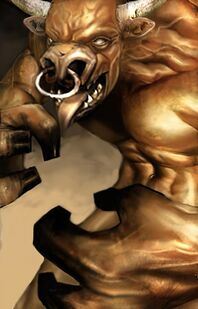
Redtip, ring fighter and a pirate from the Nelanther Isles.
- Ahurrong, the chief overseer of Thyvo Vrass's estate in Thay in the mid-to-late 14th century DR.[43]
- Karagos, a great champion of Omu in Chult whose skull was fixed on a throne in lich Acererak's ruined city.[44]
- Magrath, a minotaur pirate lord circa 432 DR.[45]
- Red Minotaur, a famed gladiator of Hillsfar who claimed his freedom in the late-14th century DR.[46][47]
- Suryris, an honorable white minotaur duelist from the Orsraun Mountains in Turmish.[48]
- Taurus, another famed gladiator of Hillsfar, a mascot and an ally of the city's Red Plumes in the mid-to-late 14th century DR.[49]
- Thoele Raervrun, a storeowner who was cursed to become a minotaur. He ran Skulls New and Used in the city of Oeble in the late 14th century DR.[50]
- Thud, an innkeeper from Thentia who ran The Inlet, renowned for its peaceful atmosphere.[51][52]
- Zaal, a minotaur trapped in a mirror of life trapping by lich Acererak.[53]
Rumors & Legends[]
- A rumor circulated tavern in late 15th century Chult. Stories claimed a lost ancient city of Omu built by minotaurs deep in the jungles and overrun by yuan-ti.[54]
Appendix[]
See Also[]
Appearances[]
Adventures
Undermountain: The Lost Level
Novels & Short Stories
Realms of Shadow: "Trial by Ordeal" • Realms of Infamy: "Laughter in the Flames" • The Fallen Fortress • The Silent Blade • Murder in Halruaa • Tymora's Luck • Depths of Madness • Heirs of Prophecy • Sword of the Gods • Prophet of the Dead • Prince of Ravens • Venom in Her Veins • Fire in the Blood
Comics
Video Games
Baldur's Gate
Board Games
Card Games
Miniatures
Organized Play & Licensed Adventures
Gallery[]
Further Reading[]
- Anthony Gerard (December 1986). “The Ecology of the Minotaur”. In Roger E. Moore ed. Dragon #116 (TSR, Inc.), pp. 33–35.
- Jennifer Clarke Wilkes, David Eckelberry, Rich Redman (February 2003). Savage Species. (Wizards of the Coast). ISBN 0-7869-2648-1.
External Links[]
Disclaimer: The views expressed in the following links do not necessarily represent the views of the editors of this wiki, nor does any lore presented necessarily adhere to established canon.
 Minotaur article at the Dragonlance Wiki, a wiki for the Dragonlance campaign setting.
Minotaur article at the Dragonlance Wiki, a wiki for the Dragonlance campaign setting. Minotaur article at the Eberron Wiki, a wiki for the Eberron campaign setting.
Minotaur article at the Eberron Wiki, a wiki for the Eberron campaign setting. Minotaur article at the NWNWiki, a wiki for the Neverwinter Nights games.
Minotaur article at the NWNWiki, a wiki for the Neverwinter Nights games. Minotaur article at the Baldur's Gate 3 Community Wiki, a community wiki for Baldur's Gate 3.
Minotaur article at the Baldur's Gate 3 Community Wiki, a community wiki for Baldur's Gate 3.
References[]
- ↑ 1.0 1.1 1.2 1.3 1.4 1.5 1.6 1.7 Mike Mearls, Jeremy Crawford, Christopher Perkins (2014-09-30). Monster Manual 5th edition. Edited by Scott Fitzgerald Gray. (Wizards of the Coast), p. 223. ISBN 978-0786965614.
- ↑ 2.0 2.1 2.2 Mike Mearls, Stephen Schubert, James Wyatt (June 2008). Monster Manual 4th edition. (Wizards of the Coast), p. 190. ISBN 978-0-7869-4852-9.
- ↑ 3.0 3.1 3.2 3.3 3.4 3.5 3.6 3.7 3.8 Skip Williams, Jonathan Tweet, Monte Cook (July 2003). Monster Manual v.3.5. (Wizards of the Coast), pp. 188–189. ISBN 0-7869-2893-X.
- ↑ 4.00 4.01 4.02 4.03 4.04 4.05 4.06 4.07 4.08 4.09 4.10 4.11 4.12 4.13 4.14 4.15 4.16 4.17 4.18 4.19 4.20 4.21 4.22 4.23 Doug Stewart (June 1993). Monstrous Manual. (TSR, Inc), p. 252. ISBN 1-5607-6619-0.
- ↑ 5.0 5.1 Gary Gygax (December 1977). Monster Manual, 1st edition. (TSR, Inc), p. 71. ISBN 0-935696-00-8.
- ↑ Gary Gygax (1982). “Booklet 2: Monsters and Magical Items”. The Lost Caverns of Tsojcanth (TSR, Inc.), p. 6. ISBN 0-935696-72-5.
- ↑ 7.0 7.1 Richard Baker (May 2003). Condemnation. (Wizards of the Coast), p. 154. ISBN 0786932023.
- ↑ 8.0 8.1 Ed Greenwood (April 1996). A Slow Day in Skullport (Realms of the Underdark). (TSR, Inc), pp. 81–147. ISBN 978-0786904877.
- ↑ 9.0 9.1 Ed Greenwood (September 1996). “Elminster's Everwinking Eye: The Border Kingdoms”. In Jeff Quick ed. Polyhedron #123 (TSR, Inc.), p. 9.
- ↑ 10.0 10.1 Troy Denning (May 1991). Blood Charge. (TSR, Inc.), p. 61. ISBN 0880388897.
- ↑ 11.0 11.1 Christopher Perkins, Will Doyle, Steve Winter (September 19, 2017). Tomb of Annihilation. Edited by Michele Carter, Scott Fitzgerald Gray. (Wizards of the Coast), p. 123. ISBN 978-0-7869-6610-3.
- ↑ 12.0 12.1 Tim Beach, Tom Prusa and Steve Kurtz (1993). “Golden Huzuz”. City of Delights (TSR, Inc), p. 19. ISBN 1-56076-589-5.
- ↑ 13.0 13.1 Mike Breault, David "Zeb" Cook, Jim Ward, Steve Winter (August 1988). Ruins of Adventure. (TSR, Inc.), pp. 86, 95. ISBN 978-0880385886.
- ↑ 14.0 14.1 Steve Kenson, et al. (November 2015). Sword Coast Adventurer's Guide. Edited by Kim Mohan. (Wizards of the Coast), p. 71. ISBN 978-0-7869-6580-9.
- ↑ Dale "slade" Henson (September 1991). “Chemcheaux”. In Jean Rabe ed. Polyhedron #63 (TSR, Inc.), pp. 26, 28–29.
- ↑ 16.00 16.01 16.02 16.03 16.04 16.05 16.06 16.07 16.08 16.09 16.10 16.11 16.12 16.13 16.14 16.15 16.16 16.17 16.18 16.19 16.20 16.21 16.22 Anthony Gerard (December 1986). “The Ecology of the Minotaur”. In Roger E. Moore ed. Dragon #116 (TSR, Inc.), pp. 32–35.
- ↑ 17.0 17.1 Bruce R. Cordell, Gwendolyn F.M. Kestrel, Jeff Quick (October 2003). Underdark. (Wizards of the Coast), p. 20. ISBN 0-7869-3053-5.
- ↑ 18.0 18.1 18.2 Bruce R. Cordell, Gwendolyn F.M. Kestrel, Jeff Quick (October 2003). Underdark. (Wizards of the Coast), p. 117. ISBN 0-7869-3053-5.
- ↑ Jeff Crook, Wil Upchurch, Eric L. Boyd (May 2005). Champions of Ruin. (Wizards of the Coast), p. 63. ISBN 0-7869-3692-4.
- ↑ 20.0 20.1 Bill Slavicsek (1993). The Complete Book of Humanoids. (TSR, Inc), p. 43. ISBN 1-5607-6611-5.
- ↑ 21.0 21.1 Wizards D&D Team (May 2022). Mordenkainen Presents: Monsters of the Multiverse. (Wizards of the Coast), p. 142. ISBN 978-0786967872.
- ↑ R.A. Salvatore (May 2000). Night Masks. (Wizards of the Coast), chap. 7, p. 77. ISBN 978-0786916061.
- ↑ So Saith Ed Feb-Apr 2004. (2004). Retrieved on 7-4-2022.
- ↑ Mike Mearls, Jeremy Crawford, Christopher Perkins (2014-09-30). Monster Manual 5th edition. Edited by Scott Fitzgerald Gray. (Wizards of the Coast), p. 51. ISBN 978-0786965614.
- ↑ Ed Greenwood, Sean K. Reynolds, Skip Williams, Rob Heinsoo (June 2001). Forgotten Realms Campaign Setting 3rd edition. (Wizards of the Coast), p. 212. ISBN 0-7869-1836-5.
- ↑ Tracy Hickman, Laura Hickman, Philip Meyers, Peter Rice, William John Wheeler (May 1987). Desert of Desolation. (TSR, Inc.), p. 51. ISBN 978-0880383974.
- ↑ Colin McComb, Dale Donovan (December 1995). “A Player's Guide to Conflict”. In Michele Carter ed. Planes of Conflict (TSR, Inc.), p. 28. ISBN 0-7869-0309-0.
- ↑ DreamForge Intertainment, Inc. (1995). Designed by Christopher L. Straka. Ravenloft: Stone Prophet. Strategic Simulations, Inc.
- ↑ Richard Baker, John Rogers, Robert J. Schwalb, James Wyatt (December 2008). Manual of the Planes 4th edition. (Wizards of the Coast), p. 81. ISBN 978-0-7869-5002-7.
- ↑ Lisa Smedman (March 2002). “Trial by Ordeal”. Realms of Shadow (Wizards of the Coast). ISBN 0-7869-2716-X.
- ↑ Elaine Cunningham (January 2001). Silver Shadows. (Wizards of the Coast), chap. 5. ISBN 978-0786917990.
- ↑ BioWare (June 2002). Designed by Brent Knowles, James Ohlen. Neverwinter Nights. Atari.
- ↑ Tom Armstrong (February 1988). “Better Living Through Alchemy”. In Roger E. Moore ed. Dragon #130 (TSR, Inc.), p. 40.
- ↑ Eric L. Boyd (September 1997). Powers & Pantheons. Edited by Julia Martin. (TSR, Inc.), p. 108. ISBN 978-0786906574.
- ↑ Mike Mearls, Jeremy Crawford (May 29, 2018). Mordenkainen's Tome of Foes. Edited by Kim Mohan, Michele Carter. (Wizards of the Coast), p. 142. ISBN 978-0786966240.
- ↑ Richard Baker (October 1995). Monstrous Compendium Planescape Appendix II. Edited by Karen S. Boomgarden. (TSR, Inc.), p. 109. ISBN 0-7869-0173-X.
- ↑ Brian R. James, Ed Greenwood (September 2007). The Grand History of the Realms. Edited by Kim Mohan, Penny Williams. (Wizards of the Coast), p. 15. ISBN 978-0-7869-4731-7.
- ↑ Bruce R. Cordell, Gwendolyn F.M. Kestrel, Jeff Quick (October 2003). Underdark. (Wizards of the Coast), p. 158. ISBN 0-7869-3053-5.
- ↑ The RPGA Staff (October 2001). “Pillars of Ravens Bluff”. In Erik Mona ed. Polyhedron #148 (Wizards of the Coast), p. 18.
- ↑ Ed Greenwood (July 1995). Volo's Guide to Cormyr. (Wizards of the Coast), p. 178. ISBN 0-7869-0151-9.
- ↑ Ed Greenwood (January 1996). Volo's Guide to the Dalelands. (TSR, Inc), p. 147. ISBN 0-7869-0406-2.
- ↑ Richard Baker, et al. (April 2015). Princes of the Apocalypse. Edited by Michele Carter, Stacy Janssen. (Wizards of the Coast), p. 120. ISBN 978-0-7869-6578-6.
- ↑ Anthony Pryor (June 1995). “Campaign Guide”. In Michele Carter, Doug Stewart eds. Spellbound (TSR, Inc.), p. 32. ISBN 978-0786901395.
- ↑ Christopher Perkins, Will Doyle, Steve Winter (September 19, 2017). Tomb of Annihilation. Edited by Michele Carter, Scott Fitzgerald Gray. (Wizards of the Coast), p. 164. ISBN 978-0-7869-6610-3.
- ↑ Ed Greenwood, Jeff Grubb (April 1998). Cormyr: A Novel. (TSR, Inc.), pp. 240–241. ISBN 0-7869-0710-X.
- ↑ Westwood Associates (1989). Hillsfar. Strategic Simulations, Inc.
- ↑ Ossian Studios (August 2019). Designed by Luke Scull. Neverwinter Nights: Tyrants of the Moonsea. Beamdog.
- ↑ BioWare (December 1998). Designed by James Ohlen. Baldur's Gate. Black Isle Studios.
- ↑ Jeff Grubb and Ed Greenwood (1990). Forgotten Realms Adventures. (TSR, Inc), p. 88. ISBN 0-8803-8828-5.
- ↑ Ed Greenwood (December 1999). “Elminster's Everwinking Eye: A Wayfarers Guide to the Forgotten Realms”. In Erik Mona ed. Polyhedron #139 (TSR, Inc.), p. 16.
- ↑ John Terra (January 1995). “Reference Guide”. In Allison Lassieur ed. The Moonsea (TSR, Inc.), p. 42. ISBN 978-0786900923.
- ↑ Ossian Studios (August 2019). Designed by Luke Scull. Neverwinter Nights: Tyrants of the Moonsea. Beamdog.
- ↑ Christopher Perkins, Will Doyle, Steve Winter (September 19, 2017). Tomb of Annihilation. Edited by Michele Carter, Scott Fitzgerald Gray. (Wizards of the Coast), p. 163. ISBN 978-0-7869-6610-3.
- ↑ Christopher Perkins, Will Doyle, Steve Winter (September 19, 2017). Tomb of Annihilation. Edited by Michele Carter, Scott Fitzgerald Gray. (Wizards of the Coast), p. 36. ISBN 978-0-7869-6610-3.

